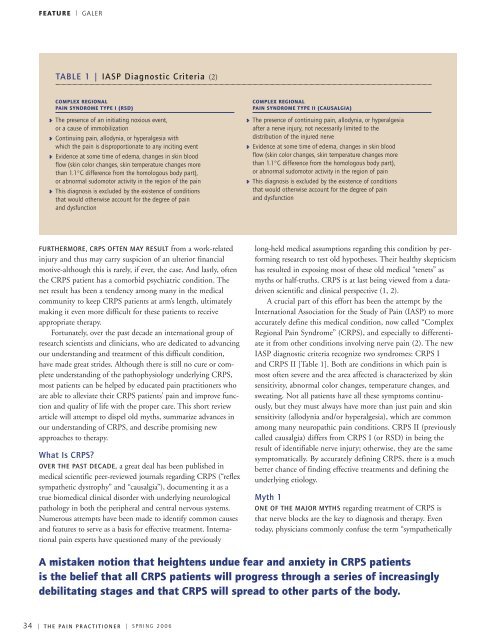printer-friendly version (PDF) - Reflex Sympathetic Dystrophy ...
printer-friendly version (PDF) - Reflex Sympathetic Dystrophy ...
printer-friendly version (PDF) - Reflex Sympathetic Dystrophy ...
Create successful ePaper yourself
Turn your PDF publications into a flip-book with our unique Google optimized e-Paper software.
FEATURE | GALER<br />
TABLE 1 | IASP Diagnostic Criteria (2)<br />
COMPLEX REGIONAL<br />
PAIN SYNDROME TYPE I (RSD)<br />
❥ The presence of an initiating noxious event,<br />
or a cause of immobilization<br />
❥ Continuing pain, allodynia, or hyperalgesia with<br />
which the pain is disproportionate to any inciting event<br />
❥ Evidence at some time of edema, changes in skin blood<br />
flow (skin color changes, skin temperature changes more<br />
than 1.1°C difference from the homologous body part),<br />
or abnormal sudomotor activity in the region of the pain<br />
❥ This diagnosis is excluded by the existence of conditions<br />
that would otherwise account for the degree of pain<br />
and dysfunction<br />
COMPLEX REGIONAL<br />
PAIN SYNDROME TYPE II (CAUSALGIA)<br />
❥ The presence of continuing pain, allodynia, or hyperalgesia<br />
after a nerve injury, not necessarily limited to the<br />
distribution of the injured nerve<br />
❥ Evidence at some time of edema, changes in skin blood<br />
flow (skin color changes, skin temperature changes more<br />
than 1.1°C difference from the homologous body part),<br />
or abnormal sudomotor activity in the region of pain<br />
❥ This diagnosis is excluded by the existence of conditions<br />
that would otherwise account for the degree of pain<br />
and dysfunction<br />
FURTHERMORE, CRPS OFTEN MAY RESULT from a work-related<br />
injury and thus may carry suspicion of an ulterior financial<br />
motive-although this is rarely, if ever, the case. And lastly, often<br />
the CRPS patient has a comorbid psychiatric condition. The<br />
net result has been a tendency among many in the medical<br />
community to keep CRPS patients at arm’s length, ultimately<br />
making it even more difficult for these patients to receive<br />
appropriate therapy.<br />
Fortunately, over the past decade an international group of<br />
research scientists and clinicians, who are dedicated to advancing<br />
our understanding and treatment of this difficult condition,<br />
have made great strides. Although there is still no cure or complete<br />
understanding of the pathophysiology underlying CRPS,<br />
most patients can be helped by educated pain practitioners who<br />
are able to alleviate their CRPS patients’ pain and improve function<br />
and quality of life with the proper care. This short review<br />
article will attempt to dispel old myths, summarize advances in<br />
our understanding of CRPS, and describe promising new<br />
approaches to therapy.<br />
What Is CRPS?<br />
OVER THE PAST DECADE, a great deal has been published in<br />
medical scientific peer-reviewed journals regarding CRPS (“reflex<br />
sympathetic dystrophy” and “causalgia”), documenting it as a<br />
true biomedical clinical disorder with underlying neurological<br />
pathology in both the peripheral and central nervous systems.<br />
Numerous attempts have been made to identify common causes<br />
and features to serve as a basis for effective treatment. International<br />
pain experts have questioned many of the previously<br />
long-held medical assumptions regarding this condition by performing<br />
research to test old hypotheses. Their healthy skepticism<br />
has resulted in exposing most of these old medical “tenets” as<br />
myths or half-truths. CRPS is at last being viewed from a datadriven<br />
scientific and clinical perspective (1, 2).<br />
A crucial part of this effort has been the attempt by the<br />
International Association for the Study of Pain (IASP) to more<br />
accurately define this medical condition, now called “Complex<br />
Regional Pain Syndrome” (CRPS), and especially to differentiate<br />
it from other conditions involving nerve pain (2). The new<br />
IASP diagnostic criteria recognize two syndromes: CRPS I<br />
and CRPS II [Table 1]. Both are conditions in which pain is<br />
most often severe and the area affected is characterized by skin<br />
sensitivity, abnormal color changes, temperature changes, and<br />
sweating. Not all patients have all these symptoms continuously,<br />
but they must always have more than just pain and skin<br />
sensitivity (allodynia and/or hyperalgesia), which are common<br />
among many neuropathic pain conditions. CRPS II (previously<br />
called causalgia) differs from CRPS I (or RSD) in being the<br />
result of identifiable nerve injury; otherwise, they are the same<br />
symptomatically. By accurately defining CRPS, there is a much<br />
better chance of finding effective treatments and defining the<br />
underlying etiology.<br />
Myth 1<br />
ONE OF THE MAJOR MYTHS regarding treatment of CRPS is<br />
that nerve blocks are the key to diagnosis and therapy. Even<br />
today, physicians commonly confuse the term “sympathetically<br />
A mistaken notion that heightens undue fear and anxiety in CRPS patients<br />
is the belief that all CRPS patients will progress through a series of increasingly<br />
debilitating stages and that CRPS will spread to other parts of the body.<br />
34 | T H E PA I N P R A C T I T I O N E R | S P R I N G 2 0 0 6
















